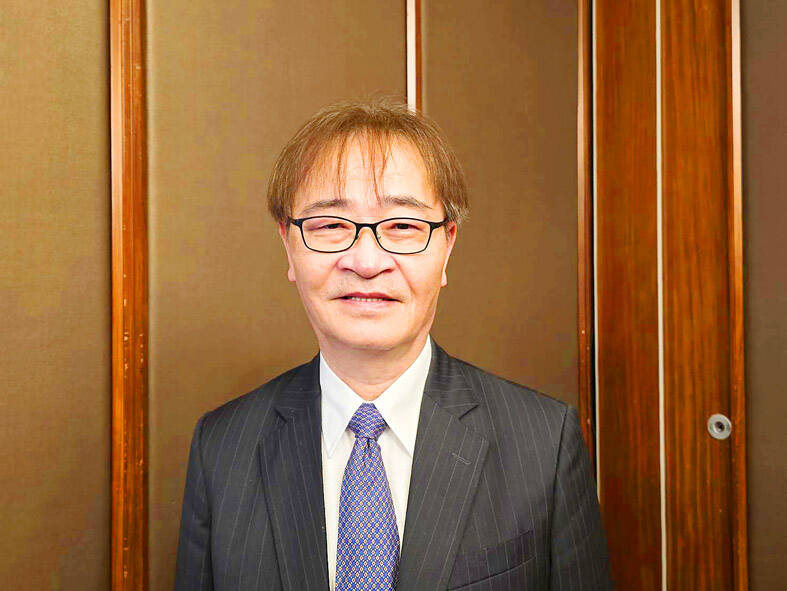Container shipper Wan Hai Lines Ltd (萬海航運) yesterday said it expects freight rates and business to remain healthy in the next few quarters, helped by rerouting needs and inventory building demand to dodge tariff hikes.
“We are positive about the business outlook in next six months and the second half of next year will depend on how the US trade policy pans out,” Wan Hai president Tommy Hsieh (謝福隆) said.
Hsieh attributed his optimism to lingering needs to divert vessels around Africa’s Cape of Good Hope since October last year to avoid attacks by Iran-aligned Houthi militants in the Red Sea.

Photo: CNA
The longer voyages have pushed freight rates higher, he said.
The disruption to container shipping traffic has reduced the industry’s capacity between the Far East and Europe by 20 percent, he said, adding that there appears no solution in sight to the Red Sea crisis.
Meanwhile, US president-elect Donald Trump has pledged to raise tariffs on goods from Canada, Mexico and China, a policy that could drive companies to build up inventory to circumvent higher costs later, Hsieh said, adding that such arrangements, seen during Trump’s first term from 2017 to 2021, would support freight rates.
Additionally, the chances of strikes by union dockworkers at ports on the US’ east and gulf coasts are escalating after Trump last week sided with the unions and expressed opposition to automation.
The Shanghai Containerized Freight Index, a critical business gauge for the industry, last week picked up 22.63 points, encouraged by Trump’s backing.
A strike would disrupt port operations and push up freight rates, Hsieh said.
A strike in October lasted only three days after the US government intervened.
Wan Hai’s earnings ability next quarter might be on par with this quarter, Hsieh said.
Port congestion would worsen next year, he said.
The average stay at Shanghai Port, the world’s largest, is three to four days, while it is three to five days at Singapore Port, Hsieh said, adding that Asian economies rely heavily on exports of raw materials and semi-finished goods.
A rise in the use of large vessels by shippers to save costs is also contributing to port congestion as docks are falling behind in processing efficiency, he said.
Furthermore, costs to charter cargo vessels this year have doubled from last year, reflecting tight supply, Hsieh said.
The backdrop would keep operating costs and freight rates high, he added.
Wan Hai runs ship and container rental businesses, shipping agencies, ship and container trading businesses, and port container terminal operations.
The company reported net income of NT$34.62 billion (US$1.07 billion) in the first three quarters of this year, or earnings per share of NT$6.57, reversing losses from the same period last year.

MULTIFACETED: A task force has analyzed possible scenarios and created responses to assist domestic industries in dealing with US tariffs, the economics minister said The Executive Yuan is tomorrow to announce countermeasures to US President Donald Trump’s planned reciprocal tariffs, although the details of the plan would not be made public until Monday next week, Minister of Economic Affairs J.W. Kuo (郭智輝) said yesterday. The Cabinet established an economic and trade task force in November last year to deal with US trade and tariff related issues, Kuo told reporters outside the legislature in Taipei. The task force has been analyzing and evaluating all kinds of scenarios to identify suitable responses and determine how best to assist domestic industries in managing the effects of Trump’s tariffs, he

TIGHT-LIPPED: UMC said it had no merger plans at the moment, after Nikkei Asia reported that the firm and GlobalFoundries were considering restarting merger talks United Microelectronics Corp (UMC, 聯電), the world’s No. 4 contract chipmaker, yesterday launched a new US$5 billion 12-inch chip factory in Singapore as part of its latest effort to diversify its manufacturing footprint amid growing geopolitical risks. The new factory, adjacent to UMC’s existing Singapore fab in the Pasir Res Wafer Fab Park, is scheduled to enter volume production next year, utilizing mature 22-nanometer and 28-nanometer process technologies, UMC said in a statement. The company plans to invest US$5 billion during the first phase of the new fab, which would have an installed capacity of 30,000 12-inch wafers per month, it said. The

Taiwan’s official purchasing managers’ index (PMI) last month rose 0.2 percentage points to 54.2, in a second consecutive month of expansion, thanks to front-loading demand intended to avoid potential US tariff hikes, the Chung-Hua Institution for Economic Research (CIER, 中華經濟研究院) said yesterday. While short-term demand appeared robust, uncertainties rose due to US President Donald Trump’s unpredictable trade policy, CIER president Lien Hsien-ming (連賢明) told a news conference in Taipei. Taiwan’s economy this year would be characterized by high-level fluctuations and the volatility would be wilder than most expect, Lien said Demand for electronics, particularly semiconductors, continues to benefit from US technology giants’ effort

‘SWASTICAR’: Tesla CEO Elon Musk’s close association with Donald Trump has prompted opponents to brand him a ‘Nazi’ and resulted in a dramatic drop in sales Demonstrators descended on Tesla Inc dealerships across the US, and in Europe and Canada on Saturday to protest company chief Elon Musk, who has amassed extraordinary power as a top adviser to US President Donald Trump. Waving signs with messages such as “Musk is stealing our money” and “Reclaim our country,” the protests largely took place peacefully following fiery episodes of vandalism on Tesla vehicles, dealerships and other facilities in recent weeks that US officials have denounced as terrorism. Hundreds rallied on Saturday outside the Tesla dealership in Manhattan. Some blasted Musk, the world’s richest man, while others demanded the shuttering of his